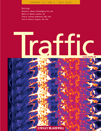
TRAFFIC
Scope & Guideline
Pioneering Insights into Biochemistry and Beyond
Introduction
Aims and Scopes
- Intracellular Trafficking Mechanisms:
Research on the cellular mechanisms responsible for the transport of proteins and organelles within cells, including studies on endocytosis, exocytosis, and vesicular transport. - Role of GTPases and Protein Complexes:
Exploration of the roles of Rab GTPases and other protein complexes in regulating intracellular transport and their implications in various diseases. - Extracellular Vesicles and Intercellular Communication:
Investigation of the biogenesis and function of extracellular vesicles in intercellular communication and their roles in disease pathology. - Pathogen Interactions and Host Cell Trafficking:
Studies examining how pathogens manipulate host cell trafficking mechanisms to facilitate infection and evade immune responses. - Disease Mechanisms Related to Trafficking Defects:
Research focused on understanding how defects in trafficking pathways contribute to various diseases, including neurodegenerative disorders, cancer, and metabolic conditions. - Technological Advances in Trafficking Analysis:
Development and application of new imaging and analytical tools to study trafficking processes at the cellular and molecular levels.
Trending and Emerging
- Mechanisms of Autophagy and Lysosomal Function:
There is an increasing emphasis on the role of autophagy and lysosomal pathways in cellular homeostasis and their implications in various diseases, particularly neurodegenerative disorders. - Role of Extracellular Vesicles in Disease:
The exploration of extracellular vesicles as mediators of disease processes and their potential as therapeutic targets is gaining momentum, indicating a growing interest in their biological significance. - Targeting Trafficking Pathways for Therapeutic Intervention:
Research focused on developing strategies to manipulate trafficking pathways as therapeutic interventions for diseases, particularly in cancer and metabolic disorders, is emerging as a critical area of interest. - Spatial-Temporal Dynamics of Trafficking:
Innovative approaches to study the spatial and temporal dynamics of trafficking processes are on the rise, including advanced imaging techniques and computational modeling. - Interdisciplinary Approaches to Trafficking Research:
There is a growing trend towards interdisciplinary studies that combine cell biology, biochemistry, and bioinformatics to provide a more comprehensive understanding of trafficking mechanisms.
Declining or Waning
- Cytoskeletal Dynamics in Trafficking:
There has been a noticeable decrease in papers focusing specifically on the role of cytoskeletal elements in intracellular trafficking, suggesting a potential shift towards more molecular and biochemical studies. - Viral Pathogenesis Mechanisms:
Research specifically addressing viral mechanisms of host cell trafficking manipulation appears to be less frequent, possibly indicating a saturation of the topic or a shift towards other emerging fields. - Basic Research on Classical Endocytosis:
Studies centered on classical endocytic pathways without a specific disease context are becoming less prominent, as the focus shifts towards more integrated approaches that combine various aspects of trafficking. - Comparative Studies Across Organisms:
The publication of comparative studies examining trafficking mechanisms across different model organisms is waning, possibly due to the increasing complexity of studies focusing on specific cellular systems.
Similar Journals

Annual Review of Biophysics
Elevating the Dialogue in Biophysics ResearchThe Annual Review of Biophysics, published by ANNUAL REVIEWS, stands as a premier journal in the field of biophysics, offering an unparalleled collection of comprehensive and insightful reviews that synthesize the latest advancements in biochemistry, bioengineering, cell biology, structural biology, and more. With an impressive Q1 ranking across multiple categories as of 2023, this journal is recognized for its significant contribution to the scientific community, highlighted by its robust Scopus ranking—placing it in the 99th percentile for biophysics and the 96th percentile for structural biology. Operating under an open access policy, the journal ensures a broad dissemination of crucial findings and theoretical advancements. As the field of biophysics continues to expand, the Annual Review of Biophysics remains essential for researchers, professionals, and students seeking to stay informed about pivotal developments that shape our understanding of biological systems at the molecular level. One may refer to the journal for current trends, innovative methodologies, and a wealth of knowledge that drives the field forward.

JOURNAL OF BIOLOGICAL CHEMISTRY
Unveiling Molecular Mysteries, One Study at a TimeJOURNAL OF BIOLOGICAL CHEMISTRY, published by Elsevier, is a premier interdisciplinary journal dedicated to advancing our understanding of biochemistry, cell biology, and molecular biology. With a prestigious history dating back to 1945 and an impressive convergence of research expected to continue through 2024, this journal holds a Q1 ranking in all three of its core categories, signaling its critical influence in the respective fields, supported by a robust Scopus ranking that places it among the top echelons of internationally recognized research. Although currently not available as Open Access, the journal is essential for researchers and professionals looking to stay abreast of the latest breakthroughs and innovations in biochemical research. With a deep commitment to scientific rigor and a focus on diverse topics ranging from cellular processes to molecular mechanisms, the Journal of Biological Chemistry serves as a vital resource for the academic community, shaping the future of biological sciences.

Cellular and Molecular Bioengineering
Transforming Ideas into Solutions in Cellular BioengineeringCellular and Molecular Bioengineering, published by SPRINGER, is a prominent journal dedicated to the exploration of interdisciplinary approaches in the fields of biochemistry, genetics, and molecular biology. With an ISSN of 1865-5025 and an E-ISSN of 1865-5033, this journal has been a pivotal resource since its inception in 2009, showcasing groundbreaking research that combines innovative modeling and simulation techniques with cellular and molecular applications. As a Q2 journal in both Biochemistry, Genetics and Molecular Biology (miscellaneous) and Modeling and Simulation categories, it ranks favorably in the Scopus metrics, placing 62nd out of 324 in Mathematics_ Modeling and Simulation, and 69th out of 221 in General Biochemistry, Genetics and Molecular Biology. The journal's commitment to quality research and its contribution to advancing academic dialogue make it essential for researchers, professionals, and students seeking to stay at the forefront of bioengineering innovation. While it currently does not offer open access, it continues to provide significant insights and empirical studies that can help shape future developments in the field, reinforcing its role as a key player in cellular and molecular bioengineering.

JOURNAL OF CELL SCIENCE
Transforming knowledge in cellular innovation.JOURNAL OF CELL SCIENCE, with ISSN 0021-9533 and E-ISSN 1477-9137, is a distinguished publication in the field of Cell Biology, released by COMPANY BIOLOGISTS LTD in the United Kingdom. Since its inception in 1966, this journal has served as a vital platform for disseminating cutting-edge research and reviews that significantly advance our understanding of cellular processes and innovations. Currently positioned in the Q1 category within the 2023 rankings, this journal is recognized for its high impact and quality, holding a notable Scopus rank of 120 out of 285 in the Cell Biology category, placing it within the 58th percentile. While not an open-access journal, it provides extensive access options for readers and institutions, ensuring that pivotal research is accessible to a wide audience. With converged publication years leading toward 2024, JOURNAL OF CELL SCIENCE continues to be an essential resource for researchers, professionals, and students alike, fostering a deeper understanding of the intricate workings of cell biology.

JOURNAL OF CELLULAR PHYSIOLOGY
Illuminating the Pathway of Life at the Cellular LevelJOURNAL OF CELLULAR PHYSIOLOGY, published by Wiley, is a leading peer-reviewed journal that has been at the forefront of cellular research since its inception in 1945. With its prestigious Q1 and Q2 rankings in the fields of Clinical Biochemistry and Cell Biology, this journal is highly regarded within the scientific community, reflecting its significant impact factor and rigorous peer-review process. Addressing the intricacies of cell function and physiology, it serves as a crucial resource for researchers, professionals, and students dedicated to advancing knowledge in the life sciences. The journal publishes cutting-edge research articles, integral reviews, and significant findings that bridge basic biology and clinical applications, ensuring access to high-quality scholarly content that informs current practices and future research directions. Although not open access, the journal maintains a rich archive of studies, making it an essential reference point for those invested in the health and biological sciences.

EXPERIMENTAL CELL RESEARCH
Exploring the Frontiers of Cell BiologyEXPERIMENTAL CELL RESEARCH is a highly respected journal published by Elsevier Inc, specializing in the dynamic and ever-evolving field of Cell Biology. With an impact factor positioned in the Q2 quartile for 2023, it ranks at the 124th position out of 285 in the Scopus Ranks, indicating a solid reputation among peers in the domains of biochemistry, genetics, and molecular biology. Since its inception in 1950, the journal has contributed significantly to the dissemination of groundbreaking research, providing a platform for studies that explore the nuances of cellular mechanisms, processes, and experimental methodologies. Although the journal currently does not offer open access, its commitment to high-quality, peer-reviewed research continues to attract submissions from leading scientists and scholars across the globe. Researchers, professionals, and students alike will find this journal an invaluable resource for keeping abreast of current developments and innovative breakthroughs in cellular science.

Cells
Pioneering Discoveries in Biochemistry and GeneticsCells, published by MDPI in Switzerland, is a leading open-access journal that has been disseminating groundbreaking research in the fields of Biochemistry, Genetics, and Molecular Biology since its inception in 2011. With an impressive E-ISSN of 2073-4409, the journal boasts a strong impact factor and ranks in the 84th percentile for Scopus ratings, underscoring its significance in advancing scientific knowledge. As a Q1-ranked journal in both 2023 and 2020, it serves as a premier platform for researchers, professionals, and students eager to explore innovative findings and methodologies. By providing unrestricted access to high-quality research, Cells plays a pivotal role in facilitating collaboration and inspiration within the global scientific community, making it an indispensable resource for anyone interested in cutting-edge discoveries in cellular biology.

NATURE REVIEWS MOLECULAR CELL BIOLOGY
Elevating research through comprehensive reviews in cell biology.NATURE REVIEWS MOLECULAR CELL BIOLOGY, published by NATURE PORTFOLIO, stands as a seminal journal in the fields of cell and molecular biology, with a significant impact factor that underscores its influence and reputation within the scientific community. Established in 2000 and continuing its legacy into 2024, this journal delivers comprehensive reviews that synthesize current knowledge and advancements in molecular and cellular processes. Respected for its high-quality articles, it has maintained a prestigious Q1 ranking in both Cell Biology and Molecular Biology categories as of 2023. With an exceptional Scopus ranking, taking the top position in its category, it attracts a readership of prominent researchers, professionals, and students eager to stay abreast of groundbreaking discoveries and methodologies. Although it does not offer Open Access, subscribers benefit from exclusive access to vital insights that foster innovative research approaches and advancements in the life sciences. The journal’s objective is to bridge the gap between research and application, providing indispensable resources to its audience while contributing to the global conversation on molecular and cellular biology.

Cell Death Discovery
Illuminating the science behind cellular mortality.Cell Death Discovery, published by Springer Nature, is a distinguished open-access journal dedicated to advancing the field of cell death research. Since its inception in 2015, the journal has rapidly established itself as a premier platform for high-quality research, currently holding a remarkable position in the Q1 quartiles across multiple categories, including Cancer Research, Cell Biology, Cellular and Molecular Neuroscience, and Immunology. With an impact factor reflecting its significant contribution to the scientific community, Cell Death Discovery invites submissions that explore the molecular mechanisms of cell death and its implications across various biomedical fields. The journal's open-access model ensures that groundbreaking research is accessible to a global audience, facilitating collaboration and dissemination among researchers, professionals, and students alike. Located in the UK, at CAMPUS, 4 CRINAN ST, LONDON N1 9XW, ENGLAND, the journal continues to support innovative scholarship and foster a deeper understanding of the processes behind cell viability, development, and disease.

Purinergic Signalling
Advancing Understanding of Molecular SignalingPurinergic Signalling, published by Springer, is a pivotal academic journal dedicated to the exploration of purinergic signaling pathways and their implications in various biological processes. Since its inception in 2004, the journal has made significant contributions to the fields of Cell Biology, Cellular and Molecular Neuroscience, and Molecular Biology, consistently ranking in the Q3 category in recent assessments. With a strong focus on the molecular mechanisms of purines and their roles in physiology and pathology, Purinergic Signalling serves as an essential resource for researchers and professionals seeking to understand the complexity of cellular communication. Although it does not offer open access, the journal ensures a broad dissemination of high-quality research findings, making it a vital tool for academic advancement in the fields of neuroscience and molecular biology. Its commitment to scholarly excellence is reflected in its Scopus rankings, where it is competitively positioned within its categories. As we approach its 20th anniversary in 2024, Purinergic Signalling continues to inspire and inform cutting-edge research in the dynamic landscape of life sciences.